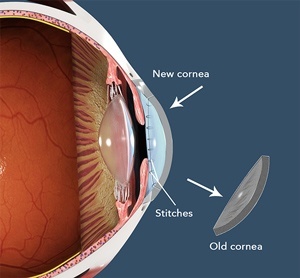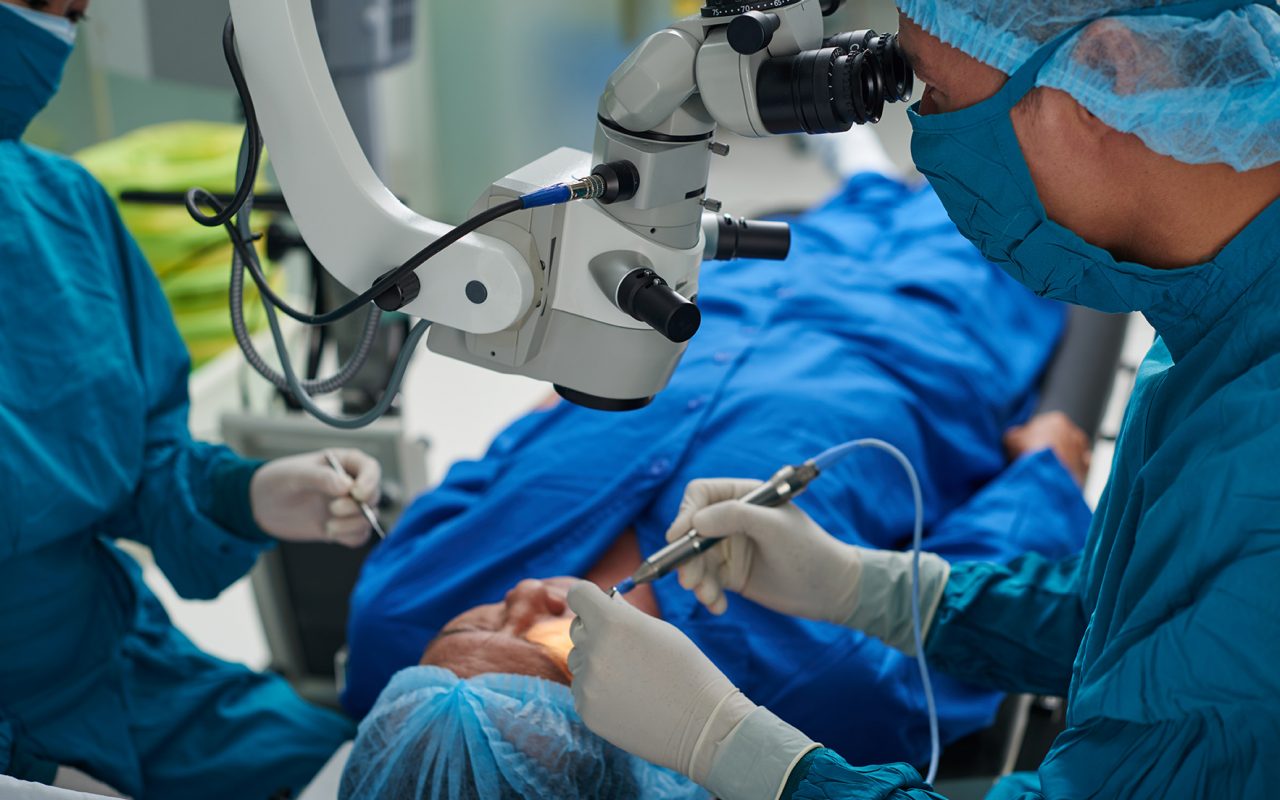Keratoplasty Surgery – Cornea Transplant
Keratoplasty Surgery
Keratoplasty surgery, in medical terms, is a very delicate surgical procedure to replace the upper part of your cornea with corneal tissue from a donor. The cornea is the transparent, dome-shaped layer that covers the upper part of your eye. Also, it is the first layer that light or image passes through your eye and plays an important and major role in your eye’s clear vision.
Moreover, a successful corneal transplant can restore your eyesight, reduce the pain caused by the cornea in your eye, and improve the appearance of a damaged or diseased eye.
Especially, most corneal transplant procedures are successful. However, a corneal transplant carries a small risk of complications, such as rejection of the donor cornea.
Particularly, a corneal transplant is most often performed to restore vision to a patient with a damaged cornea. A corneal transplant can also alleviate the signs and symptoms associated with corneal diseases.
Diseases or symptoms treatable with a corneal transplant
- Elimination of the negative effects on the cornea of those with keratoconus.
- Causes of thinning or tearing of the cornea.
- Corneal infections or injury to the cornea caused by injury swelling of the cornea.
- Corneal ulcers that do not respond to medical treatment.
- Complications from previous eye surgery.
- Fuchs dystrophy, an inherit condition.
Are there risks to corneal transplant surgery?
A corneal transplant is a relatively safe surgery. Still, every medical surgery carries a risk of complications that can happen with the operation, such as:
- Eye Infection.
- Increased pressure inside the eyeball (glaucoma).
- Problems with the sutures used to fix the donor cornea.
- Rejection of the donor cornea.
- Eye-Bleeding.
- Retinal problems such as retinal detachment or swelling.
- Signs and symptoms of corneal rejection.
- Your body’s immune system may mistakenly attack the donor cornea. This is called rejection and may require medical treatment or another corneal transplant.
- Vision loss.
- Eye-pain.
- Red eyes.
- Light sensitivity.
There is a risk of rejection in approximately 10% of corneal transplants.
How is a corneal transplant done?
In corneal transplantation, either all or part of the diseased cornea is removed and replaced with Corneal tissue from a healthy donor. Also, your eye surgeon will decide which method to follow in corneal transplantation.
Methods followed in Cornea Transplantation
Penetrating keratoplasty (PK) means transplanting a full-thickness cornea. Therefore, your surgeon cuts out your diseased cornea to remove a thickened disc of the desired size from the corneal tissue in your eye. A special tool is use to make this precise circular cut. A properly cut donor cornea is place in the opening. Your surgeon then uses very thin “sturms” (stitches) to stitch the new cornea in place. These stitches are remove later by your doctor according to the healing process.
- Endothelial keratoplasty (EK). These procedures remove diseased tissue from the posterior corneal layers, including the endothelium and a thin layer of tissue (Descemet’s membrane) that protects the endothelium from injury and infection. Donor tissue replaces the removed tissue.
There are two types of endothelial keratoplasty:
The first type, called Descemet stripping endothelial keratoplasty (DSEK), uses donor tissue to replace about one-third of the cornea.
- The second type, call Descemet’s membrane endothelial keratoplasty (DMEK), uses a much thinner layer of donor tissue. The tissue use in DMEK is extremely thin and fragile. This procedure is more difficult than DSEK and is widely use.
- Anterior lamellar keratoplasty (ALK). Two different methods are apply: The diseased tissue is remove from the anterior corneal layers, including the epithelium and the stroma, but leaving the posterior endothelial layer in place.
The depth of corneal damage determines the type of ALK procedure that is right for you. Superficial anterior lamellar keratoplasty (SALK) replaces only the anterior layers of your cornea, leaving healthy stroma and endothelium intact. A deep anterior lamella transplant (DALK) procedure is use when corneal damage extends deeper into the stroma. Healthy tissue from a donor is then add to replace the remove part.
Artificial corneal transplant (keratoprosthesis).
In some cases, an artificial cornea (keratoprosthesis) may be use if people are not suitable for a corneal transplant from a donor cornea.
Especially, your doctor will discuss which corneal transplant surgery method is best for you. Also, what to expect during the procedure and explain the risks of the procedure.
During the corneal transplant, you will take sedative to help you relax and a local anesthetic to numb your eye. If your doctor prefers, he can put you to sleep with general anesthesia. Either way, you won’t feel any pain or soreness.
What to expect after cornea transplant surgery is completed:
Especially, you should use your medicines as your doctor has told you. Our eye surgeon may give you eye drops, oral medications. Also, these eye drops help your new cornea adjust to your body.
Be sure to take precautions to protect your eyes. Especially, use the eye shields or safety glasses provide to you during recovery. Also, do not rub or press your eye. Because, you will need to take extra care and precautions to avoid damaging your eyes for the rest of your life.
Moreover, you will need to be follow closely medically. Also, you will need to have regular check-ups with our eye surgeon after the surgery to monitor the healing process and prevent complications.
Most people who have a corneal transplant can partially or completely improve their vision. Whether everything goes well after your corneal transplant depends on your health.
Particularly, your risk of complications and corneal rejection continues for years after your corneal transplant. Therefor, you should have your eye doctor check-ups every year. Also, the risk of corneal rejection can usually be manage with medications.
Especially, as your eye tries to adapt to the new cornea after the surgery, your vision may initially be worse than before the surgery. It may take several months for your vision to improve.
Also, after the outer layer of your cornea has healed within a few months, your eye doctor can apply treatments that can improve your vision.
However, astigmatism may occur in your eyes due to the stitches that have to be remove during corneal transplants. Therefore, this can make your vision blurry at some points. Also, your doctor may try to solve this problem by making adjustments to your stitches.
Correction of vision problems.
Especially, refractive errors such as near and farsightedness can be correct later with glasses, contact lenses or, in some cases, laser eye surgery.
Useful Links
What is Keratoplasty Surgery cost. About Eye Uveal Melanoma – Eye Cancer Treatment. Vitrectomy Surgeries. Keratoconus Cross-Linking Surgery. Penetrating Keratoplasty(eyewiki by AAO)
Definitely avoid low-cost Cornea Transplant
You may think that a cheap Keratoplasty Surgery is right for you. This might be fine if you're buying a cheap TV, but it's not worth the gamble with your eyesight. But as you know, having cheap eye surgery means sacrificing technology, physician quality, medical care and sterile conditions, and most importantly, taking risks. The issues that fall on a patient who wants to have cataract surgery and should pay the most attention; The hospital with the latest technology in cataract surgery and imaging devices, a sterile environment, and an experienced doctor and clinical team should be selected. We would like to remind all our patients that they only have two eyes and that the most important and most sensitive sense organ is their eyes.
None of these things are more important than your eye health, and we do not compromise on quality and cutting-edge technology. We offer you our prices in a very understandable, fair and affordable way.
There are no hidden costs in our pricing. We make Keratoplasty Surgery affordable for you.


 Penetrating keratoplasty (PK) means transplanting a full-thickness cornea. Therefore, your surgeon cuts out your diseased cornea to remove a thickened disc of the desired size from the corneal tissue in your eye. A special tool is use to make this precise circular cut. A properly cut donor cornea is place in the opening. Your surgeon then uses very thin “sturms” (stitches) to stitch the new cornea in place. These stitches are remove later by your doctor according to the healing process.
Penetrating keratoplasty (PK) means transplanting a full-thickness cornea. Therefore, your surgeon cuts out your diseased cornea to remove a thickened disc of the desired size from the corneal tissue in your eye. A special tool is use to make this precise circular cut. A properly cut donor cornea is place in the opening. Your surgeon then uses very thin “sturms” (stitches) to stitch the new cornea in place. These stitches are remove later by your doctor according to the healing process.



